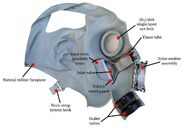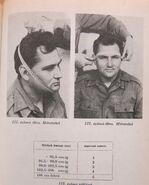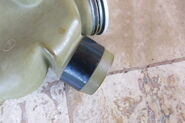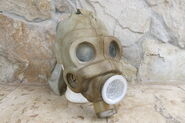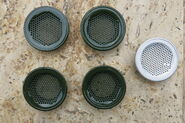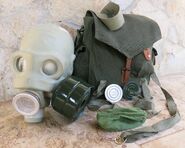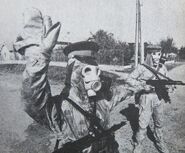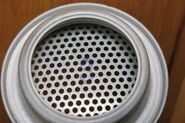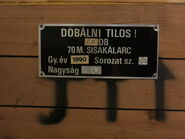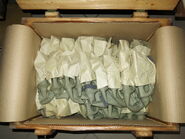The Hungarian 70M is a licensed variant of the PMG. The mask was issued to the Néphadsereg (Hungarian People’s Army), Munkásőrség (Worker’s Militia), Polgári védelem (Civil Defence) and to other organisations in the Belügyminisztérium (ministry of the interior) like Határőrség (Border guards) and Rendőrség (Police), after the regime change also to the Magyar Honvédség (Hungarian Army).
Overview[]
The 70M facepiece is made of rubber, a different injection moulding technique and rubber (DA4 rubber in "gray clour II" on the facepiece but the filter connection thread is made of styrene) was used than on the original Soviet ShMG mask. It has two flat circular glass eyepieces (the glass is one layered while on the ShMG is double layered), which can fit anti-fog inserts. The eyepieces are just a bit angled to aid the use of optical equipment. For soldiers who had glasses, special lenses were available in theory, but in reality there were none. There is a speech diaphragm located under a removable cover on the front of the mask, there are more and smaller holes on the cover than on the PMG. The doubled exhalation valve located towards the bottom of the mask, under the diaphragm. There are masks with black exhalation valve covers. The strip which hides the wire that is fixing the speech diaphragm on the later ones (after ~1983) was changed to plastic from canvas. Around the same time the rim of the eyepieces were also changed to smoother angled one from the older scalar one. The mask takes a GOST-compliant filter to the side, in a thread unusually made from rubber, the air reaches the inside through moustache arranged Tissot tubes. There is a flat metal circle behind the inhale valve which helps to maintain the shape of the mask. For the left-handed soldiers left-handed masks were made but only in small numbers, for this reason left-handed PMGs were imported as well numbers but the diaphragm cover was changed. The 70M has a grey-colored strap at the back of the mask, its purpose being to allow a better seal, but the mask is secure on the head without its use being employed. The holes on the helmet part of the mask were made for ventilation of the head so the wearer wouldn't experience overheating. It also decreases the pressure on the head by the mask. The mask was made in 5 sizes and used the Soviet sizing system.
Filter[]
Main article: 70M filter
The 70M filter is nearly identical to the one on the PMG (EO-18k).
Carriers and kit[]
70M bag[]
The originally intended carrier of the 70M is the 70M bag, it is an impregnated dark olive-colored canvas bag, in small numbers "Rába" camouflage pattern bags were also made. There are four separated parts inside. The biggest one is for the mask and weapon decontamination kit (FVCs-M). The smaller one is for the filter(s), there is a small canvas piece that is meant to be separate the first and spare filter if it was issued. The flat part is for the chemical gloves. The little pocket is for the anti-fog inserts and the spare membranes. There are 3 pockets on the outside. The big one on the front is for the personal decontamination kit (SzVCs) the side pockets are for the drug injections against nerve agents (KÉPA), iodine pills and water disinfectant tablets. There are 4 canvas straps on the front. Those are for to fix the 67M and 75M Összfegyvernemi védőkészlet (joint service general-purpose personal protective equipment) leg parts. For carrying it has an adjustable shoulder strap and an also adjustable waist strap connecting with a carabiner to a D-ring.
87M tactical vest[]
The modernisation of the field gear led to the 87M tactical vest. Among many pockets for munitions and equipment one was reserved for the gas masks. This pockes is placed on the left, sewn to the belt part. It is smaller compared to the 70M bag, so there is no place for a spare filter, but the spare membranes and anti-fogging lenses could be placed in the small pocked on the back side of the mask storing pocket.
The kit[]
- 70M facepiece
- 70M filter (1 but sometimes a spare one was issued as well)
- carrier, either 70M bag or 87M tactical vest pocket
- Hydrophobic socket for filters
- 70MPM Lemez (56mm anti-fogging inserts in tin x6) or sometimes antifog soap but this option is not common
- Spare membranes in the tin (x4)
Service[]
![]() Magyar Néphadsereg (Hungarian People's Army)
Magyar Néphadsereg (Hungarian People's Army)
![]() Munkásőrség (Worker's Militia)
Munkásőrség (Worker's Militia)
![]() Magyar Honvédség (Hungarian Defence Forces)
Magyar Honvédség (Hungarian Defence Forces)
![]() Belügyminisztérium (Ministry of the Interior)
Belügyminisztérium (Ministry of the Interior)
The mask was used with 67M and 75M Összfegyvernemi védőkészlet (joint service general-purpose personal protective equipment) and with 65M Könnyű gázvédő ruha (light gas protection suit) for the chemical troops and rocket fuel refillers. Just before the regime change for testing purposes, 120 units of 89M Fólia védőlepel (foil protective cloak) was issued to the infantry. The highest number in service by the Magyar néphadsereg was 639000 in 1986 and altogether 1065000 masks were purchased.
![]() Polgári védelem (Civil Defence
Polgári védelem (Civil Defence![]() )
)
The mask was used to heavy decontamination alongside with the 60M. The 70M was used with the 75M Összfegyvernemi védőkészlet (joint service general-purpose personal protective equipment) because it was more suitable for civilian purposes than the 67M. The Könnyű gázvédő ruha (light gas protection suit) was also used with it.
External information[]
Development[]
Inside the Warsaw Pact the license for general service equipment was free, so because in 1967-1968 the Soviet Union had the modernest masks (the M10, MP-4 and M74 weren't developed yet) Hungarian engineers inspected some Soviet designs in the Yaroslavl Tire Factory (Ярославский шинный завод) and the PMG was chosen. The technical documents were translated and the production line was built, but as mentioned above the engineers implemented many changes compared to the PMG, here it is worth to mention the name of László Halász, László Pongó and Ferenc Mikle who played a big role in the success. In 1969 the mask was ready for trials, where it was proven superior to the 60M, however there were some problems as well. The filter leaked too much charcoal dust, the filter connection was too soft so when screwing in a filter there was a chance that the seal broke, four sizes are not enough and producing the FMB filtering paper is much more complicated than it was expected. All of these problems were solved, most notably the charcoal was changed to an ammonia impregnated one, the whole body of the filter was redesigned and size 5 masks were introduced.
Manufacturers and markings[]
The rubber facepieces were made by Taurus Gumiipari Vállalat while the assembling was made by Medicor Légzésvédelmi Készülékek Gyára, this is why there are different dates on the outside of facepiece (by Taurus) and on the stamps (by Medicor). Medicor also produced the antifog inserts and membranes. The bags were made by Salgótarjáni Ruhagyár, while the vests were produced by Sapka és Kalap Szövetkezet. The masks were packed in NK50 wooden chests, 50 same sized in each. Filters and bags were packed separately, either in NK50 or NK30 chests. The first masks were made in 1969 and the last ones in 1991, approximately 1100000 masks were produced.
Price[]
One 70M kit costed 594,7 Forints in the 1970s. The mask was 282; the filter 106; the anti-fogging lenses 9,7; the spare membranes 5,9 and the bag 115 Forints.
Popular culture[]
Interestingly but not that surprisingly the 70M bag has a greater impact on the popular culture than the mask itself. Because the 70M bag or as it is called in the slang szimatszatyor (flair bag) or szumka (from the Russian сумка - bag) was made of cheap and durable impregnated canvas combinated with a perfect size and outside pockets it is very suitable for everyday civilian use (for example as a school bag). Since the late 70s, the bag is widely used mostly by rock and punk groups alongside with (bachelor of arts) (university) students. Those groups sometimes also decorate their bags with the logo of their favourite band(s) or with other badges and patches. In the 80s one bag worth a bottle of Pálinka (famous Hungarian alcoholic drink) but because of the regime change and the modernisation of the army (the stockpiles were sold on auctions) the price is drastically dropped.
Export[]
In 1978 the Hungarian government sent 6000 masks to Mozambique as a gift, it is possible that the shipment contained 70M masks too.
The Hungarian government have offered 3000 masks for the Gulf War to the coalition army but because of the slow administration, the war was over before the cargo was even shipped.
References[]
- Módszertani segédlet a rendszeresített egyéni vegyvédelmi eszközök használatára (book-1973)
- Munkásőrség: Kézikönyv az alegységparancsnokok felkészüléséhez (book-1980)
- https://www.youtube.com/watch?v=61vawM_VV4M (at 10:00)
- http://www.hadmernok.hu/154_09_halaszl_pi.pdf (page 90 bottom)
- Regiment 2006/4
- 70M gázálarc készlet és a 70M gázálarc javító egységkészlet képes katalógusa
- Magyar atom-, biológiai- és vegyi- (ABV) védelmi technikai almanch (2003)
- https://combatgear.blog.hu/2011/05/09/87m_malhamelleny
- https://www.youtube.com/watch?v=vZX-zpkYDtw
- https://www.youtube.com/watch?v=VVlUtPmTuos


